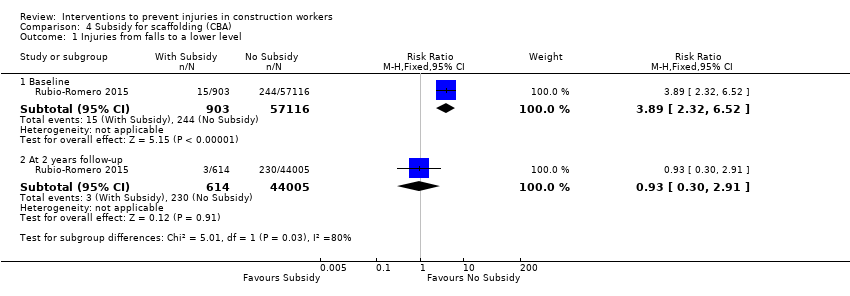| Study ID | Methods | Participants | Interventions | Outcome per 100 person‐years |
| Altayeb 1992 | Before‐after study | Construction workers (31 companies, no control group) | Drug testing programmes issued from 1985 to 1988 in USA | Number of injuries: before: 11.2; after: 9.1; absolute change: 2.1 |
| Darragh 2004 | Before‐after study | Residential construction workers (97 companies, no control group) | Safety education and training programme, issued in 1997 in USA (also booklet, focused inspection and financial incentives were used) | Number of injuries: before: 17.4; after: 14.7; absolute change: 2.7 Number of LWDI: before: 5.8; after: 3.5; absolute change: 2.3 Number of LWDI and medical cost: before: 3.8; after: 2.2; absolute change: 1.6 |
| Evanoff 2016 | Before‐after study | 1018 apprentice carpenters in residential construction (no control group) | Educational intervention: training utilised hands‐on, participatory training methods preferred by the learners to address the safety gaps in the curriculum, including ladder use, leading edge work, truss setting, and use of scaffolding and personal fall arrest. Rolled out in USA in 2007 | Number of self‐reported falls: before 18.2; after: 14.5; absolute change 3.7 |
| Gerber 2002 | Before‐after study | Construction workers (49 companies, no control group) | Drug‐testing programmes issued from 1985 to 1999 in USA | Number of injuries: before: 8.9; after: 4.4; absolute change: 4.5 |
| HSA 2006 | Before‐after study (not enough data points) | Construction workers (142,100 in 1999 to 206,000 in 2004) | Construction regulations for safe work environments issued in 2001 in Ireland | Number of injuries: in 1999: 0.4; in 2004: 0.7; absolute change: 0.3 Number of fatal injuries per 1,000,000 person‐years: in 1999: 113; in 2004: 73; absolute change: 40 |
| Johnson 2002 | Before‐after study | Carpenters and drywall tapers from variety of ethnic backgrounds (5 administrators plus 50 workers, no control group) | A job safety programme (toolbox, training, stress management techniques) issued in 1998 in USA | Number of injuries: before: 26.8; after: 12.9; absolute change: 13.9 Number of lost days: before: 23.5; after: 2.4; absolute change: 21.1 |
| Kim 2016 | Retrospective cohort study | 1298 patients who suffered work‐related fall injuries. | Preventive effects of safety helmets: emergency‐department based occupational injury database with work‐related injury patients who visited 10 emergency departments between July 2010 and October 2012 in Korea. Surveillance database was used to evaluate the extent to which safety helmets have an effect on reducing the risk of traumatic brain injury resulting from work related fall injuries by comparing the effect across different heights. | Usage of helmets: 45% work‐related fall injured patients were wearing safety helmets. Intracranial injury was high at 8.7% in the no safety helmet group and 4.6% in the safety helmet group. There was significant preventive effects of safety helmet on intracranial injury when the height of fall was less than 4 m. OR 0.42 (95% CI 0.24 to 0.73) |
| Marcucci 2010 | Before‐after study | Electricians in Ontario, Canada | Multifaceted electrical burn prevention programme (starting in 2004) consisting of education, facilitation: -
survey to understand the multimeter problem, best practice review, technical research -
awareness raise -
behavioural change through proper safety precautions -
influence product design -
new product design and stimulate market place | No denominator reported Non‐fatal injuries, i.e. electrical burns through multimeters Before (1998 to 2005): 26 electrical burn injuries caused by multimeters After (2006 to 2008): 0 electrical burn injuries caused by multimeters |
| Nelson 1997 | Retrospective cohort study | Construction workers (784 employers, control group of 8301 employers) | Washington State fall protection standard, violation during 1991 to 1992 in USA | Number of fall injuries: before intervention group: 1.8; before control group: 1.0; after intervention group: 1.4; after control group: 1.0; absolute change difference between intervention and control group: 0.4 |
| Ohdo 2014 | Before‐after study | — | Amended occupational safety and health regulations in Japan in 2009: installation of mid‐rails, lower bars and other similar structures to prevent falls from the space between a guardrail and the work platform erected on scaffolds | Scaffold‐related fall accidents: Decrease over years 1552 (2007), 1227 (2008), 828 (2009), 718 (2010), 871 (2011) |
| Salminen 2008 | Before‐after study | Company 1: 172 drivers/electricity workers Company 2: 179 drivers/electricity workers | Company 1: 3, 45‐60 min group discussions Company 2: 1‐day course in anticipatory driving | Company 1 Number of work‐related road injuries: before: 10.5; after: 2.9; absolute change: 7.6 Number of other occupational injuries: before: 42.4; after: 48.8; absolute change: 6.4 Company 2 Number of work‐related road injuries: before: 2.2; after: 3.4; absolute change: 1.2 Number of other occupational injuries: before: 23.5; after: 28.5; absolute change: 5.0 |
| Williams 2010 | Before–after study | Latino day labourers in USA | Training safety and health awareness of 1 day based on active learning and problem solving through peer trainers. Training materials adapted from OSHA curriculum and pilot | No denominator reported Non‐fatal injuries leading to stop with work Any serious injury last 6 months: before: 21% (N = 64); after: 24% (N = 16) At least 2 serious injuries last 6 months: before: 16% (N = 36); after: 1.5% (N = 1) |














